Eggplant can be broiled, grilled, sautéed, steamed, pan-fried, or stuffed and baked. You can make ratatouille or eggplant parmesan.
The mild flavor and light, spongy texture of the eggplant make it a good match for other vegetables, browned and chopped meat, cooked fish, or shellfish.
Favorite eggplant recipe
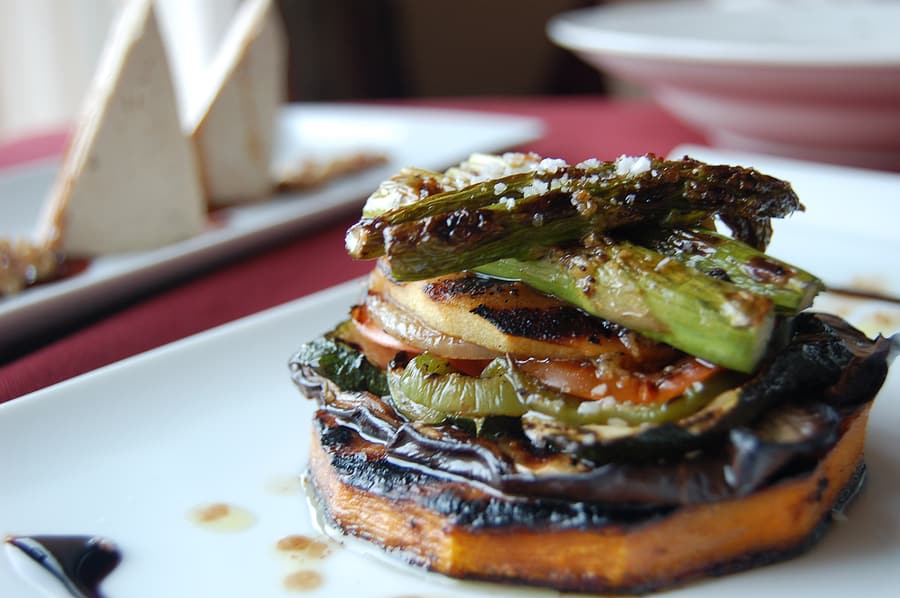
The subtle flavor and meaty texture of eggplant make it especially versatile in cooking. Perhaps that’s why eggplant is found in so many cuisines around the world.
One of the strengths of eggplant is its ability to absorb the flavor of whatever it is cooked with and at the same time add a creamy bulkiness to a dish.
The dark purple, bulbous, egg-shaped eggplant (called ‘aubergine’ almost everywhere but in the United States) is the most recognizable eggplant in most markets. But the long Oriental types are catching on, and other varieties–such as the tiny green Thai eggplant–can be found on occasion.
You can’t eat eggplant raw, but you can cook eggplant in many ways: boil, steam, sauté, stir-fry, braise, bake, deep-fry, grill, broil, and microwave.
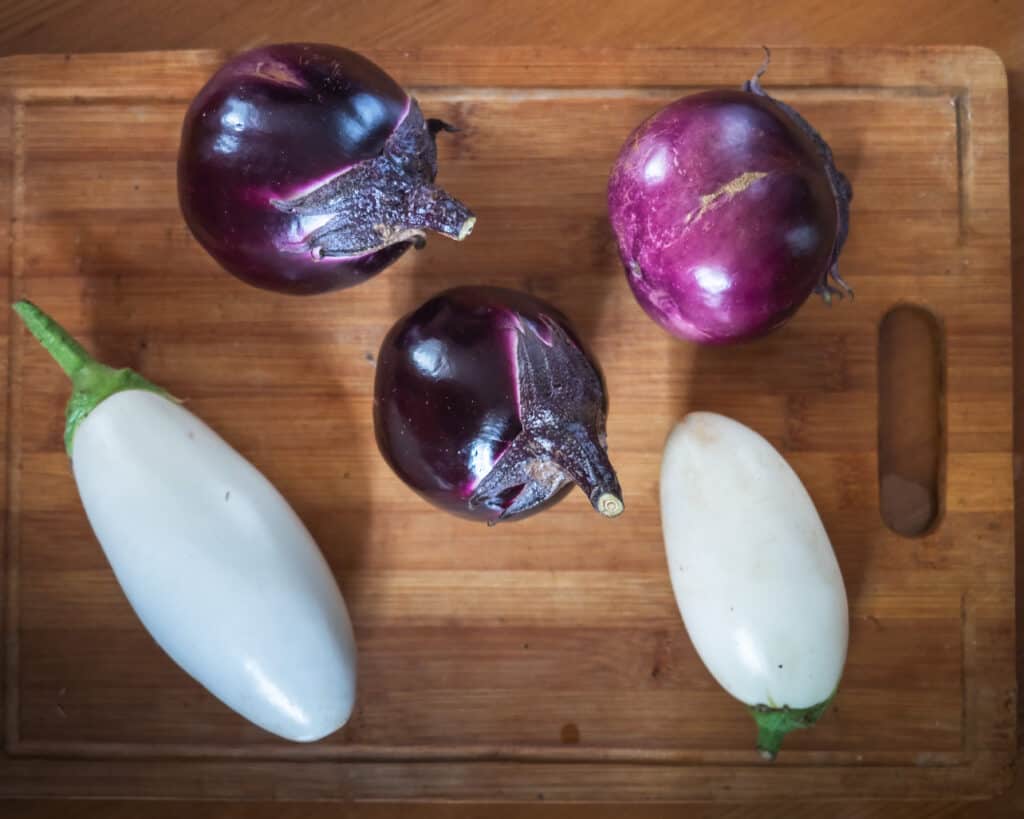
Types of eggplant
- The classic Western eggplant is cylindrical- or pear-shaped with smooth, glossy, deep purple skin and a green calyx or stem cap. But the eggplant—which is botanically speaking a berry, not a vegetable—can assume many shapes and colors.
- Besides the Western eggplant, other purple eggplants include the Japanese eggplant and the Chinese eggplant—both of which are very slender and barely cylindrical.
- The deep purple Japanese eggplant is long, straight, and slender with a bright green calyx or cap. The lavender-purple Chinese eggplant is longer than the Japanese eggplant with a purple calyx.
- In Thailand, small, round eggplants are pale green with white and bright orange stripes. The ‘Turkish Orange’ eggplant looks more like a tomato than an eggplant, and the ‘Red Ruffled’ eggplant also looks much like a small tomato.
- The white eggplant—which is often used for pickling and is thought to have originated in India—is the same size and shape as an egg with a skin that is firm and smooth. No doubt, the white eggplant is how the eggplant got its name.
How to choose eggplant
- Select eggplants that are shiny, firm, and heavy for their size.
- The full-colored purple eggplant will take on a dull greenish-bronze color when it becomes overripe.
- A mature eggplant will be soft enough that thumb pressure will leave an indentation in the flesh of the fruit.
- Avoid eggplants that are bruised or have wrinkled skin.
- Overgrown eggplant will become soft and spongy and will be bitter tasting.
How to store eggplant
- Eggplant will keep for up to four days in the refrigerator crisper inside a plastic bag. The eggplant will shrivel as it ages.
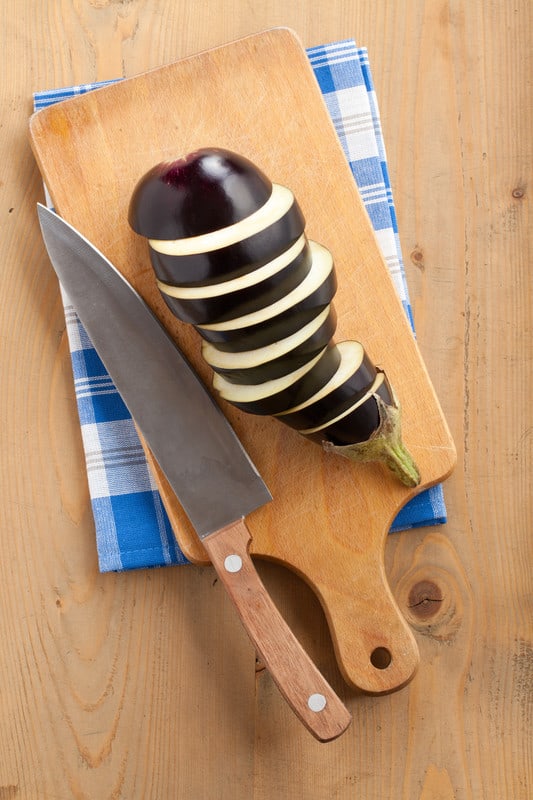
How to prep eggplant for cooking
- Young eggplant does not need to be peeled. It can be washed and the ends trimmed before cooking.
- Western eggplant varieties may require salting to remove bitter juices before cooking.
- Trim the stem end; cut the eggplant into slices about ¼ inch (¾ cm) wide; peel or discard the end slices; soak in cold salted water for 30 minutes or until the eggplant releases brown juice; drain and proceed with the recipe.
- As an alternative, salt the slices and place them between sheets of paper towels, weigh them down with a heavy plate, and let them sit for one hour.
- Eggplant easily soaks up cooking oils so it is best to coat eggplant slices with flour, batter, or crumbs before cooking to inhibit fat absorption.
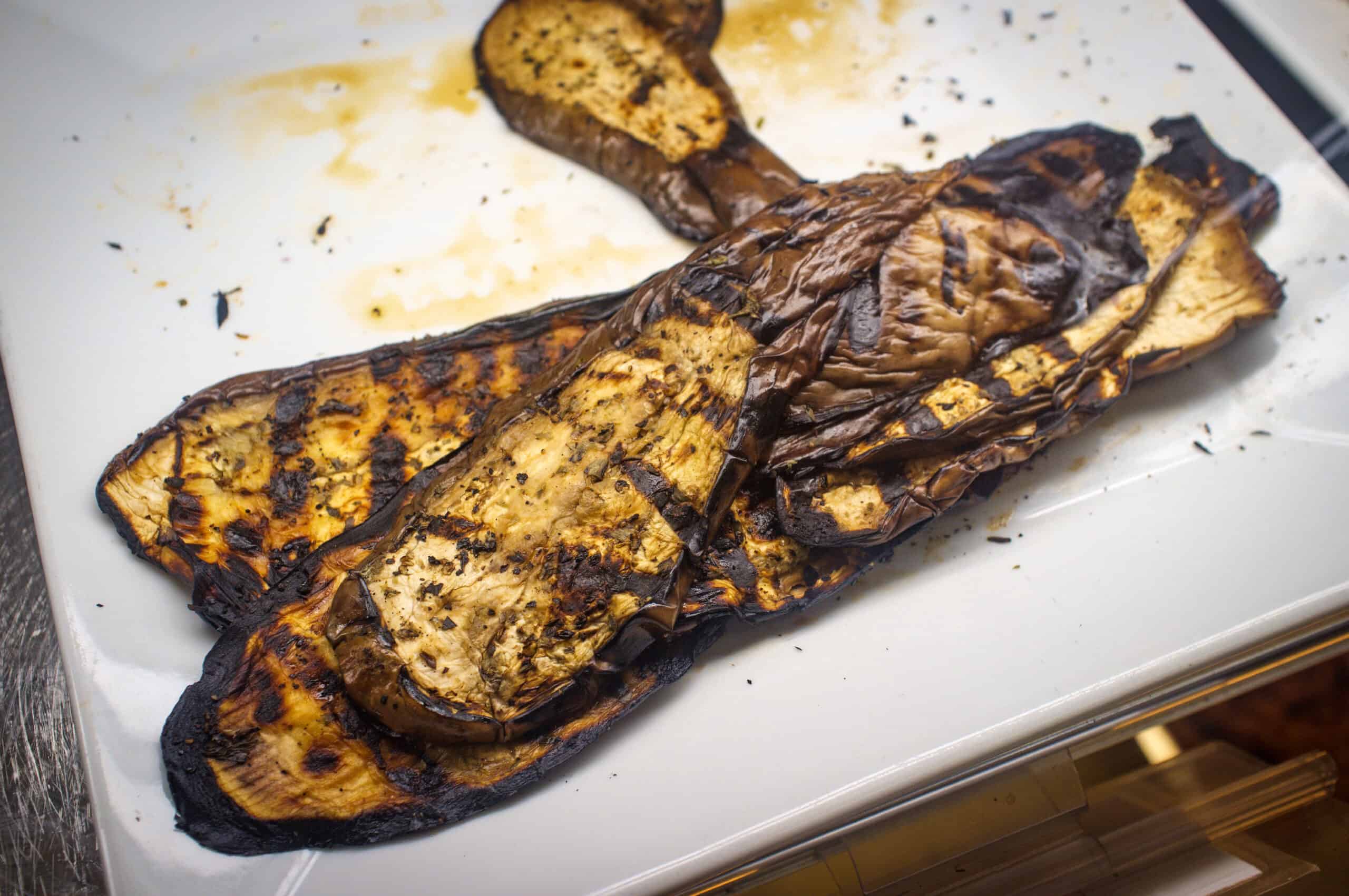
How to broil or grill eggplant
- Peel the eggplant and cut it into ½-inch-thick slices and salt (see preparation above).
- Heat broiler or grill to moderately high heat; place broiler rack or grill 4 inches from heat.
- Brush eggplant with olive oil and place oiled side down on a baking sheet directly on the grill.
- Sprinkle the opposite side with olive oil.
- Broil or grill until browned on both sides, about 10 minutes, turning for even cooking; brush with more oil if eggplant looks dry
- Serve hot or at room temperature.
How to sauté eggplant
- Peel the eggplant and cut it into ½-inch-thick cubes and salt (see preparation above).
- Coat the bottom of a deep skillet with 1/3 cup of olive oil.
- Heat the skillet and oil over medium heat.
- When the skillet is hot add the eggplant.
- Stir and toss until the eggplant begins to release some of the oil it has absorbed, about 5 to 10 minutes.
- Cook and stir frequently until the eggplant is tender, about 30 minutes, perhaps longer.
- About 5 minutes before it is done, add a bit of minced garlic and salt and freshly ground pepper to taste.
Eggplant can be sautéed with sliced bell pepper, onion, zucchini, summer squash, cubed potatoes, cauliflower, and shallots.
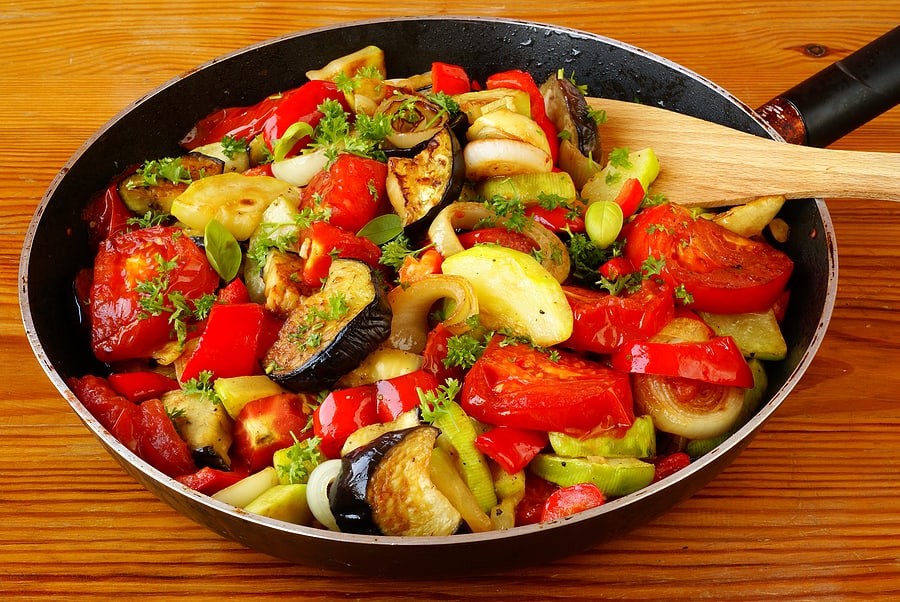
How to make ratatouille
Using about 2 pounds of eggplant.
- Peel the eggplant and cut it into ½-inch-thick cubes and salt (see preparation above).
- Coat the bottom of a deep skillet with 1/3 cup of olive oil and add 1 medium onion chopped and nearly a tablespoon of minced garlic.
- Heat the skillet and oil over medium heat.
- When the skillet is hot add the eggplant.
- Stir and toss until the eggplant begins to release some of the oil it has absorbed, about 5 to 10 minutes.
- Cook and stir frequently until the eggplant is tender, about 30 minutes, perhaps longer.
- Stir in 2 cups of chopped ripe fresh tomatoes.
- Cook for another 10 minutes and add a bit more minced garlic.
- About 5 minutes before it is done, add a bit of minced garlic and salt, and freshly ground pepper to taste.
How to steam eggplant
Asian eggplants are easily steamed.
- Trim the eggplant and halve lengthwise.
- Set a steamer basket just above the water in a pot and bring the water to a boil.
- Place the eggplant in the basket and steam until very tender, about 15 minutes.
- Cool the eggplant until it can be handled then slice with a knife and toss in a soy or sesame sauce to flavor and moisten.
- Serve warm or at room temperature.
How to pan-fry eggplant
- Prepare 1 to 1¼ pounds (.4-.5 kg) eggplant, cutting it into ½-inch-thick (13 mm) slices and salting as described above.
- Heat 2 tablespoons (30 ml) olive oil or salad oil in a wide frying pan over medium-high heat.
- Add a single layer of eggplant, without crowding; cook, turning as needed, until browned on both sides and soft throughout when pierced (8 to 10 minutes).
- Add oil as needed until all eggplant is cooked.
- Lower heat to medium if the eggplant browns too quickly.
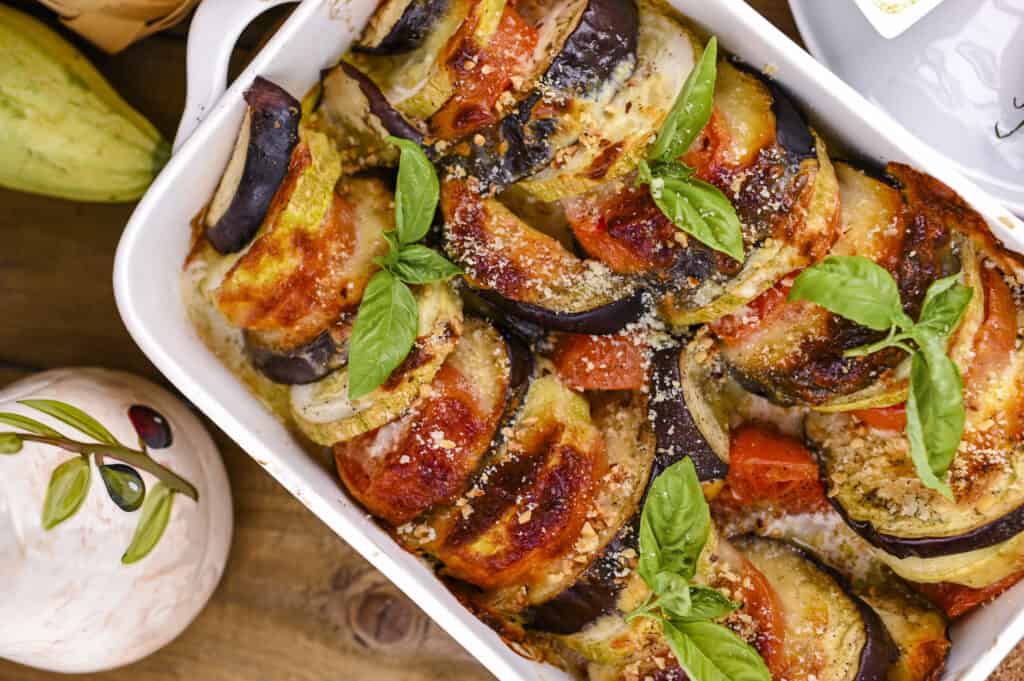
How to make eggplant parmesan
Ingredients: 2 medium to large eggplants; olive oil; all-purpose flour; 2 cups tomato sauce; 8 ounces grated mozzarella cheese; cup grated Parmesan cheese; basil leaves.
- Peel the eggplant and cut into ½-inch thick slices.
- Preheat the oven to 350 degrees F.
- Put 3 tablespoons of olive in a large skillet over medium heat.
- Dredge the eggplant slices in flour one at a time; shake off excess.
- Cook the eggplant uncrowded in batches; cook on each side until brown, about 3 to 4 minutes.
- Lightly sprinkle with salt and pepper. Add oil to the skillet if needed.
- Drain the eggplant pieces on a paper towel.
- Lightly oil a baking dish then spoon in a bit of tomato sauce.
- Top with a layer of eggplant then add a layer of each cheese and a few fresh basil leaves.
- Repeat until all of the ingredients are used. Sprinkle Parmesan on top.
- Bake until the dish is bubbling hot, about 20 to 30 minutes
- Mince basil on top and serve hot or at room temperature.
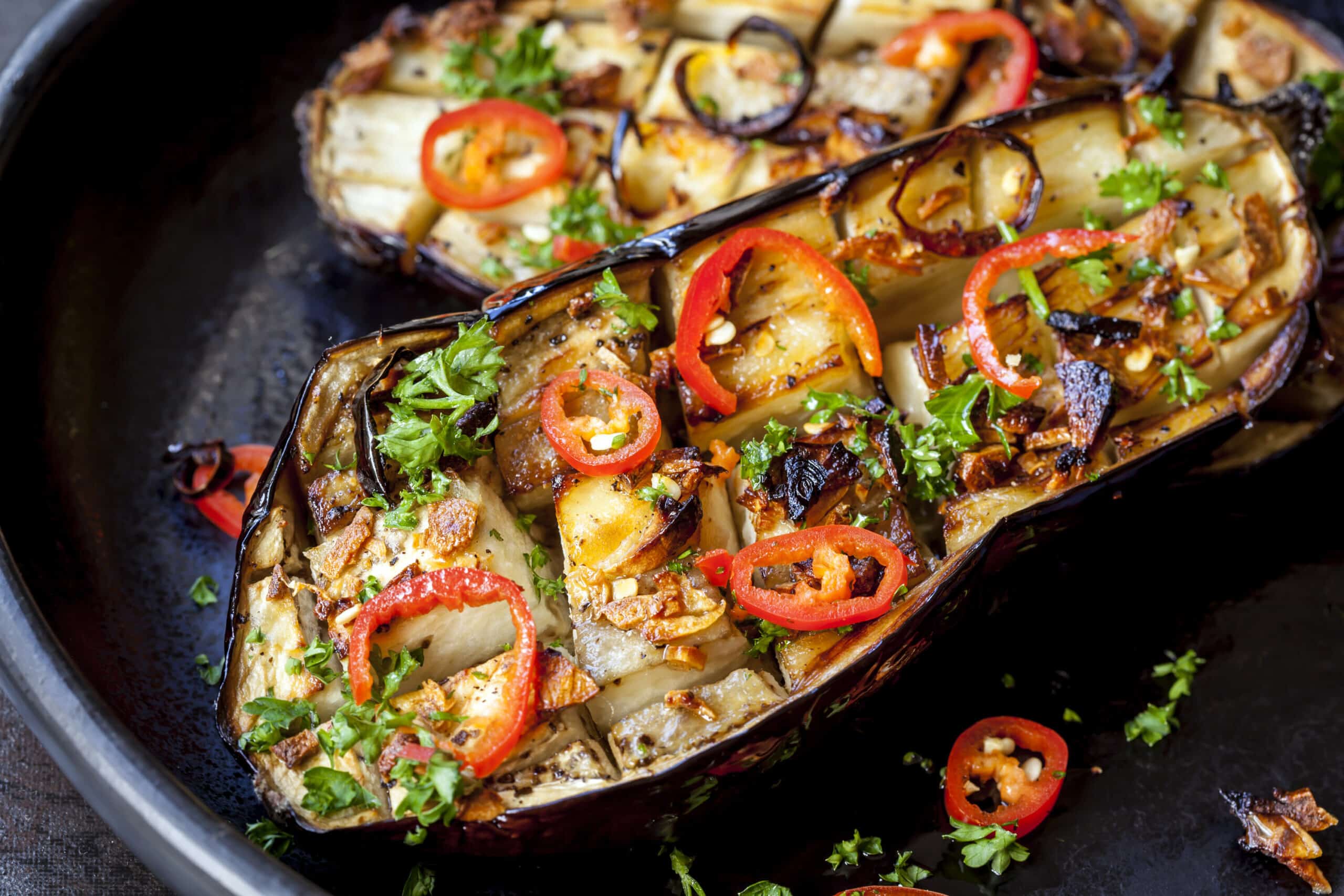
How to bake eggplant
- Cut eggplants into ½-inch-thick (13 mm) slices; brush all sides with olive or salad oil.
- Arrange in a single layer in a shallow baking pan.
- Bake, uncovered, in a 450ºF (232ºC) oven until well browned and soft when pierced (20 to 30 minutes).
Top hot cooked eggplant with garlic butter, basil, oregano, marjoram, or minced parsley. Top baked sliced with sliced tomato and shredded Cheddar or Romano cheese; return to oven until cheese is melted.
How to bake stuffed eggplant
You will need two sauté pans for this recipe.
- Cut the 2 small eggplants in half and scoop out the meat; leave enough skin to hold the eggplant together during baking.
- Chop the eggplant meat and sauté it in olive oil with minced garlic.
- In a second pan, sauté 2 cups of croutons or diced bread until the bread is crisp and brown.
- Chop anchovy fillets and combine them with the eggplant and croutons
- Add olive and season to taste; add lemon juice and grated rind.
- Stuff the eggplant halves with the mixture and brush with olive oil
- Place the halves in a baking dish with 1 cup of broth and bake at 350 degrees F or 40 minutes.
- Serve hot.
More eggplant serving suggestions
Eggplant has a mild flavor somewhat similar to fried oysters. Eggplant can be:
- Skewered and grilled.
- Halved, stuffed, and baked.
- Stewed with tomatoes and peppers or with oil and garlic.
- Sliced, layered with cheese and tomato sauce, and baked parmigiana. Coated in egg and breadcrumbs and deep-fried.
- Used as a meat or pasta substitute.
- Used in curries as in Southern India.
- Pickled, braised with pork, or fried in tempura batter as in Asia.
- Included in pasta sauces, baked dishes, and relish caponata as in Italy.
- Layered with ground lamb or other meat and topped with a béchamel sauce to make the Greek moussaka.
- Combined with cheese, tomatoes, onions, garlic, and meat make a Mediterranean casserole.
- Grilled, mashed, and mixed with seasonings to make the Middle Eastern dish baba ghanoush.
- Combined with tomatoes, onions, peppers, garlic, and herbs make the French stew ratatouille.
- Turkish cookery is said to have more than 1,000 recipes for preparing eggplant. One eggplant dish popular in the Arab world is called Imam bayildi—which means “the priest fainted.” It consists of eggplant stuffed with onions and sometimes tomatoes and cooked with olive oil.
- One small or medium-sized eggplant split lengthwise will make two shells perfect for stuffing as its own casserole dish. Just mix the flesh of the eggplant together with bread crumbs, stuff the shells, and bake.
Eggplant flavor partners
- Eggplant has a flavor affinity for beans, capers, celery, garlic, ginger, hot peppers, lamb, marinara sauce, melting cheeses, mushrooms, onions, Romano cheese, sesame oil, sesame paste, soy sauce, summer squash, sweet bell peppers, and tomato.
- Season eggplant with salt, pepper, onion, garlic, dill, basil, oregano, paprika, marjoram, parsley, sage, rosemary, or thyme.
Eggplant nutrition
- Eggplant contains dietary fiber and some protein.
- One-half cup of cooked eggplant contains 19 calories.

Get to know eggplant
- The eggplant is an herbaceous perennial usually grown as an annual. It has large, lobed, velvety gray leaves that are 4 to 5 inches (10-12 cm) long.
- Classic pear-shaped eggplant berries can range from 5 to 12 inches (13-30 cm) long. Other varieties with white, green, yellow, or mottled green fruits are smaller. The flesh of the eggplant is greenish-white to white.
- Each plant usually produces 3 to 4 well-developed fruits which in some varieties can weigh up to 2 pounds (0.75 kg) or more each. Only the fruit of the eggplant is edible, all other parts are poisonous.
- The skin of a young eggplant is edible but toughens with age. The flesh of classic Western eggplants has more moisture and is more bitter than that of the Asian varieties. To draw off the eggplant’s bitter juices, western eggplants are often salted before cooking. Asian eggplant varieties are not bitter and do not require salting.
- The eggplant is botanically a berry. In botany, a berry is a simple fleshy fruit in which the entire ovary wall ripens around the seed and is edible. Examples of other botanical berries include tomato, grape, avocado, persimmon, guava, and chile pepper.
- In Great Britain and France and in many other parts of the world, eggplant is called “aubergine”.
- The word aubergine traces the eggplant’s travels from its native India to Europe. Aubergine is derived from the Sanskrit word for the eggplant: vatin gana. Vatin gana became badingen in Persian when the eggplant was introduced to the Near East. Badingen became al-badingen in Arabic as the plant traveled further west, and when the Moorish invaders introduced the eggplant to Spain in the sixteenth-century al-badingen became alberginia in Catalan Spanish. Aubergine is a corruption of al-badingan and albadingena.
- The first eggplants to reach Europe were white and egg-shaped. The eggplant originated in India but was first cultivated in China in the fifth century B.C. The small egg-like eggplant is still popular in Spain today and is often pickled.
- The botanical name for eggplant is Solanum melongena.
- A related plant is S. integrifolium which is sometimes called tomato-fruited eggplant or gilos. This plant is cultivated in Asia and Africa and bears red- and orange-fruited eggplants rarely exceeding 2 inches (5 cm) in diameter.
Eggplant articles at Harvest to Table:
How to Plant and Grow Eggplant
How to Harvest and Store Eggplant
Eight Ways to Cook and Serve Eggplant
Eggplant Growing Problems: Troubleshooting
Articles of interest:
Best Herbs for Container Growing
Garden Planning Books at Amazon:
- Vegetable Garden Almanac & Planner
- Kitchen Garden Grower’s Guide Vegetable Encyclopedia
- Vegetable Garden Grower’s Guide
- Tomato Grower’s Answer Book
More kitchen tips:
Bring your harvest to the table. Kitchen prep tips and easy recipes for the vegetables you grow. Click below for vegetable prep and recipes you can use now.
- Almonds
- Apples
- Apricot
- Aprium
- Artichoke
- Arugula
- Asparagus
- Avocado
- Bamboo Shoots
- Banana
- Basil
- Beans, Dried
- Beans. Long
- Beans, Shell
- Beans, Snap
- Beets
- Bitter Melon
- Blackberry
- Bok Choy
- Broccoli
- Broccoli Raab
- Brussels Sprouts
- Cabbage
- Cardoon
- Carrots
- Cauliflower
- Celeriac
- Celery
- Chard
- Chayote Squash
- Cherimoya
- Cherries
- Chestnut
- Chickpea
- Chinese Cabbage
- Chives
- Cilantro
- Citron
- Clementine
- Collards
- Coriander
- Corn, Sweet
- Corn, Baby
- Corn Salad, Mache
- Cranberry
- Cress
- Cucumber
- Daikon
- Dandelion
- Dill
- Eggplant
- Endive, Belgian
- Endive and Escarole
- Fava Beans
- Fig
- Florence Fennel
- Garlic
- Ginger
- Grapefruit
- Grapes
- Guava
- Horseradish
- Jerusalem Artichoke
- Jicama
- Jujube
- Kale
- Kiwifruit
- Kohlrabi
- Kumquat
- Leeks
- Lemongrass
- Lemons
- Lettuce
- Lime
- Mache (Corn Salad)
- Mandarin Orange
- Mango
- Maple Syrup
- Marjoram
- Melons
- Michihili
- Mint
- Mizuna
- Mushrooms
- Mushrooms, Cremini
- Mustard Greens
- Napa Cabbage
- Nectarine
- Okra
- Olives
- Olive oil
- Onions
- Oranges
- Oregano
- Parsley
- Parsley Root
- Parsnips
- Passion Fruit
- Pawpaw
- Peaches
- Pears
- Peas, Garden Snap
- Peas, Snow
- Pei Tsai
- Peppers, Chili
- Peppers, Sweet
- Persimmon
- Pineapple
- Pineapple Guava
- Plantain
- Plums
- Pluots
- Pomegranate
- Potatoes
- Prickly Pear
- Pumpkin
- Quince
- Radicchio
- Radishes
- Raspberries
- Rosemary
- Rhubarb
- Rutabaga
- Sage
- Salsify
- Sauerkraut
- Savory
- Shallots
- Sorrel
- Spinach
- Squash, Summer
- Squash, Winter
- Strawberries
- Sunchokes
- Sunflower
- Sweet Potato
- Swiss Chard
- Tangerine
- Taro
- Tarragon
- Thyme
- Tomatillo
- Tomato
- Turnip
- Turnip Greens
- Yams



